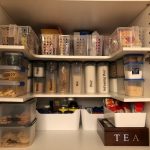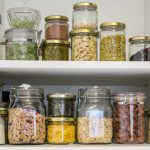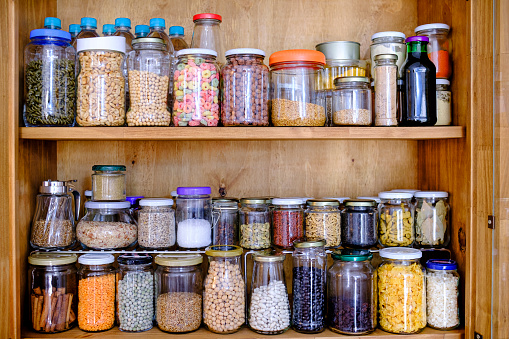So it’s a wet and windy, supposedly summer, day today. Perfect for doing a bit of spring cleaning. Why not sort out, or start, a basic pantry? Or, in my case, write about how to do one!

Having a pantry, or a couple of cupboards, holding basic ingredients is perfect to enable spontaneity in your cooking and baking. It’s worth taking the time and trouble to set one up rather than simply buy ingredients as you go for one recipe at a time. Which basics you need, depends entirely on your taste and dietary preferences. But, there are some basics that almost everyone should hold:
- Flour – plain and self raising
- Baking powder
- Sugar – white granulated
- Icing sugar
- Cocoa powder
- Table salt and ground pepper
- Tinned tomatoes
- Tinned baked beans
- Tinned kidney beans
- Dried pasta
- Rice
- Eggs
- Butter
- Onions
- Potatoes
- Cooking oil
- Vinegar
On top of the basics, a number of items can top up and personalise your stock:
- Specialist flour – ciabatta, white bread, brown bread, barley flour, gluten free flour etc
- Cream of tartar
- Baking soda
- Cornflour
- Dried yeast
- Sugar – white castor, light brown, dark brown
- Sugar substitute
- Dried milk powder
- Dried herbs – basil, oregano, marjoram, thyme, rosemary, sage, parsley, dill etc
- Fresh herbs – as above
- Dried spices – paprika, chilli, chinese five spice, various curry spices, cinnamon, nutmeg, ginger, garlic salt, cardamom etc
- Fresh ginger root
- Fresh garlic bulb
- Sea salt
- Black peppercorns
- Tomato paste
- Coconut milk
- Tinned water chestnuts
- Pasta – shells, quills, spirals, spaghetti, linguini, lasagne sheets etc
- Rice – long grain, basmati, etc
- Tinned beans and pulses
- Dried pulses
- Jam – to taste
- Chutney and pickles – to taste
- Chocolate
- Dried parmesan cheese
- Tinned fruits
- Tinned vegetables
- Tinned soups
- Olive oil
- Extra virgin olive oil
- White vinegar
- Porridge oats
- Maple syrup
- Treacle
- Dried fruits – sultanas, raisins etc
- Nuts – walnuts, peanuts, cashew nuts, brazil nuts etc
- Peanut butter
It doesn’t matter if you have a walk-in pantry, a standalone pantry cupboard, or just a standard kitchen cupboard or two. What matters is that you set up a stock of basics that reflect your standard day-to-day cooking style. If you never cook curries, then holding a vast array of fragrant Indian spices would be wasteful.
Be aware of items that have a short, or relatively short, lifespan – such as any fresh items. Aim to rotate items when you buy new. Although very tempting to fill a pantry immediately, unless you cook a lot and often, it’s better to only buy small amounts that won’t simply go off and be wasted.
 Some people decant items into glass storage jars such as Kilner jars, and in baskets, but this is purely for aesthetic purposes. There’s no real need to. What I would suggest, although it still could be considered cosmetic, is to line the shelves before you fill them. It doesn’t matter what you use, whether it be beautifully intricate lace, oil cloth, old newspaper, or anything in between. It simply helps to keep the cupboard clean especially when something is spilt. Having had to wash out a cupboard following a treacle ‘incident’, this is something I’d always recommend.
Some people decant items into glass storage jars such as Kilner jars, and in baskets, but this is purely for aesthetic purposes. There’s no real need to. What I would suggest, although it still could be considered cosmetic, is to line the shelves before you fill them. It doesn’t matter what you use, whether it be beautifully intricate lace, oil cloth, old newspaper, or anything in between. It simply helps to keep the cupboard clean especially when something is spilt. Having had to wash out a cupboard following a treacle ‘incident’, this is something I’d always recommend.
Once you have a number of pantry staples, you’ll find it so much easier to be spontaneous with your cooking. Grab that bargain item, knowing you don’t have to think on the spot for something to do with it and spend more than you’ve saved in buying the basics to cook with it.
If nothing else, a good spring clean is very therapeutic. So maybe I should stop procrastinating and go and get on with clearing out my own cupboards.
Love
Maggie x

